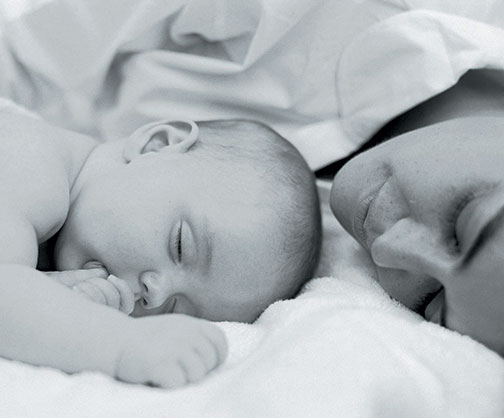Update: 22 November 2024
Toxic Metals are Passed from Mother to Fetus
Study's Authors: M. Savabieasfahani, M. Hoseiny, S. Goodarzi - Bulletin of Environmental Contamination and Toxicology
During pregnancy, to protect the mother, her detoxification system acts to discard toxic heavy metals into the developing fetus. The research team hopes their work will create greater awareness of, and initiate protections against, the growing levels of environmental toxicity.
Toxic Heavy Metals in Infants and Mothers

In this study, the levels of toxic and essential trace metals found in both the newborn and its mother's hTMA were reviewed. Toxic metals including cadmium (157 vs. 87.5 μ/kg), mercury (246 vs. 198 μg/kg), copper (14,313 vs. 11,776 μg/kg) and aluminum (52,022 vs. 408,207 μg/kg) were all higher in the newborn's hair when compared with their mother's hTMA; suggesting that metals may be discarded in the fetus as a detoxification method. Researchers compared their data with available data from Germany and Poland and recognized overall similarities.
Source: Springer Link
Find a hTMA PractitionerReferences
- Ask K, Åkesson A, Berglund M, Vahter M (2002) Inorganic mercury and methylmercury in placentas of Swedish women. Environ Health Perspect 110:523–526 Cross reference →
- Batista BL, Rodrigues JL, Souza VC, Barbosa F (2009) Fast ultrasound assisted extraction for trace elements determination in hair samples by ICP/MS for forensic analysis. Forensic Sci Int 192:88–93 Cross reference →
- Buncombe A (2005) US forced to import bullets from Israel as troops use 250,000 for every rebel killed. Indep Lond. https://www.belfasttelegraph.co.uk/
- Cavdar AO, Bahçeci M, Akar N, Dinçer FN, Erten J (1991) Maternal hair zinc concentration in neural tube defects in Turkey. Biol Trace Elem Res 30:81–85 Cross reference →
- Fang MZ, Mar W, Cho MH (2002) Cadmium affects genes involved in growth regulation during two-stage transfor-mation of Balb/3T3 cells. Toxicology 177:253–265 Cross reference →
- Gaetke LM, Chow CK (2003) Copper toxicity, oxidative stress, and antioxidant nutrients. Toxicology 189:147–163 Cross reference →
- Gundacker C, Fröhlich S, Graf-Rohrmeister K, Eibenberger B, Jessenig V, Gicic D, Prinz S, Wittmann KJ, Zeisler H, Vallant B, Pollak A, Husslein P (2010) Perinatal lead and mercury exposure in Austria. Sci Total Environ 408:5744–5749 Cross reference →
- Holmes AS, Blaxill MF, Hale BE (2003) Reduced levels of mercury in first baby haircuts of autistic children. Int J Toxicol 22:277–285 Cross reference →
- Kim SA, Jeon CK, Paek DM (2008) Hair mercury concentrations of children and mothers in Korea: implication for exposure and evaluation. Sci Total Environ 402:36–42 Cross reference →
- Kolluru GK, Tamilarasan KP, Geetha Priya S, Durgha NP, Chatterjee S (2006) Cadmium induced endothelial dysfunction: consequence of defective migratory pattern of endothelial cells in association with poor nitric oxide availability under cadmium challenge. Cell Biol Int 30:427–438 Cross reference →
- Popko J, Olszewski S, Hukałowicz K, Markiewicz R, Borawska MH, Szeparowicz P (2003) Lead, cadmium, copper and zinc concentrations in blood and hair of mothers of children with locomotor system malformations. Pol J Environ Stud 12:375–379
- Razagui I, Ghiribi I (2005) Maternal and neonatal scalp hair concentrations of zinc, copper, cadmium, and lead: relationship to some lifestyle factors. Biol Trace Elem Res 106:1–27 Cross reference →
- Souad C, Farida Z, Nadra L, François B, Bougle D, Azeddine S (2006) Trace element level in infant hair and diet, and in the local environment of the Moroccan city of Marrakech. Sci Total Environ 370:337–342 Cross reference →
- Srinivas M, Gupta DK, Rathi S, Grover JK, Vats V, Sharma JD, Mitra DK (2001) Association between lower hair zinc levels and Neural Tube Defects. Indian J Pediatr 68:519–522 Cross reference →
- Wilhelm M, Lombeck I, Ohnesorge FK (1994) Cadmium, copper, lead and zinc concentrations in hair and toenails of young children and family members: a follow-up study. Sci Total Environ 141(1–3):275–280